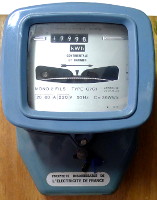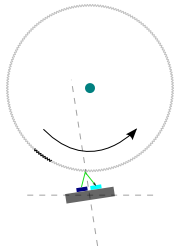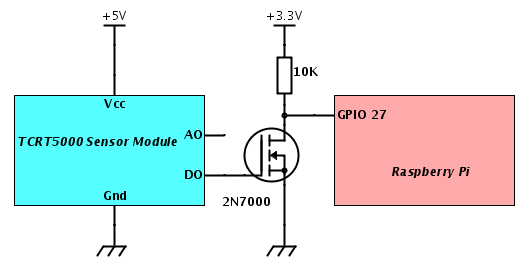Now the gas meter has been connected... would there be any chance to do the same with electricity?
Not easy bordering on impossible
A lot of solutions (specially American & British ones) use current transformers clipped straight on to either the live or neutral wire. These can give real-time and very accurate readings. Trouble is, on french installations, both wires are usually combined together in a outer plastic sheath and in the "worst" case not even visible at any point!
Playing within the fuse box not being a great option the only remaining possibility was to "read" the meter itself.
All modernish counter have at least impulse (usually a LED) output. Some more recent even have a "teleinformation" serial communication system, not even talking about the latest generation of smart meter with a USB port).

Mine is a very old rotating disk without any kind of bells and wistles... in short the worst case scenario.
After a bit of research I found what could potentially be the needed part: Fludia FM250. Unfortunately it doesn't seem to exist anywhere else.
Knowning that my meter could be upgraded at anytime by the electricity provider, I wanted to stay on a cheap and low key solution. Some people on Jeelabs forums mentioned the TCRT5000 also saying that they didn't have much luck!
But googling this reference leads to IR Sensor TCRT5000 for Arduino as well as a TCRT - Infra Red reflectivity sensor + break out board from Ciseco which mention on their website "Revolving or tumblimg numbered Electricity meters".
Having found a "Infra-red reflective distance sensor Module tracing line" (basically a TCRT5000 + LM393) on eBay for a grand total of 6€, I decided to give it a go.
Never give-up!
To cut the story short... it works! I tried first in 5V then in 3.3V and in both case the black line could be detected but...
- The alignment with the wheel is a real pain
- Hooking physically the circuit on the meter box is also a real pain
- Tuning the detection level is tricky
The temporary setup (made of cardboard and sellotape/scotch tape) has been in place for quite a while but I will need to find a better system before the next meter reading by the company.
It is worth mentioning that the detection is better (or simply working) when the sensor is installed at an angle as illustrated below.

Crashing
I noticed that sometimes the LM393 (part of the module) crashed and stopped detecting the black zone. It seems that the component doesn't like having its output forced to a voltage. When the Raspberry Pi boots, there is no garantee that the GPIO will be in INPUT mode and voltage free. So, to separate the two, I inserted a transistor (a 2N7000 I had in stock but it should be similar with a NPN). Moreover, it gives the possibility of using 5V for the sensor as if 3.3V should work, in practice it is relatively unstable.
And counting...
The counting set-up on the Raspberry Pi is the same as the gas one. That said, there is also a form of bounce (not mechanical but the result is the same) and so far I haven't managed to completely get rid of it, specially when there are bogus pulses a few seconds apart. I capped (like for the gas) the delay between pulses but this potentially means that I loose accuracy when the disk is spinning very fast.
So accuracy might not be that great but so far it still gives a pretty good picture of the electricity usage and with such a cheap design, it doesn't really bother me.
Schematic
